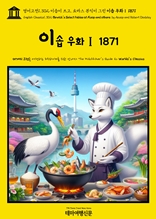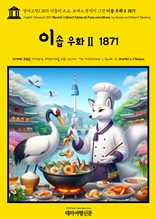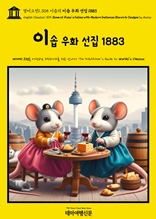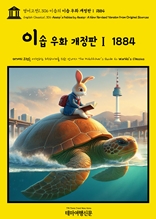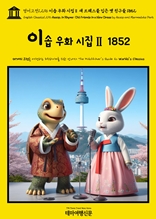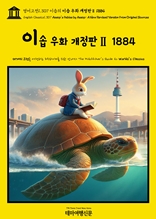영어고전1,302 이솝이 쓰고, 토마스 뷰익이 그린 이솝 우화Ⅰ 1871(English Classics1,302 Bewick's Select Fables of Æsop and others. by AESOP and Robert Doodler)
도서정보 : 이솝(Aesop, B.C.620~B.C.564) | 2024-03-31 | EPUB파일
지원기기 : PC / Android / iOS
▶ 이솝이 쓰고, 토마스 뷰익이 그린 이솝 우화 1871(Bewick's Select Fables of Æsop and others. by AESOP and Robert Doodler) 3부작 : 이솝 우화는 최초로 그리스어(Greek)로 작성되었으며, 이후 라틴어를 비롯한 다양한 유럽언어와 전 세계의 언어로 번역되면서 ‘인류의 우화집’으로 사랑받고 있습니다. 이에 따라 이솝 우화집은 수많은 시대와 언어, 편집자, 삽화가에 따라 수백, 아니 수천 종으로 발간되었을 정도로 수많은 판본을 자랑합니다. 이솝 우화집은 때로는 저명한 편집자의 판본으로, 때로는 당대 유명삽화가의 버전으로 지금 이 순간에도 세계 각지의 독자들의 손에 들려 있습니다. 테마여행신문 TTN Korea은 이솝이 쓰고, 토마스 뷰익이 그린 이솝 우화 1871(Bewick's Select Fables of Æsop and others. by AESOP and Robert Doodler)에 수록된 142편의 이솝 우화를 3부작으로 분권하여 소개해 드립니다. 테마여행신문 TTN Korea 영어고전(English Classics) 1,999선과 함께 어제도, 오늘도, 내일도 멋진 문학여행을!
▶ AN ESSAY UPON FABLE. : Fable is the method of conveying truth under the form of an Allegory. The sense of a Fable is entirely different from the literal meaning of the words that are used to compose it; and yet the real intention thereof is visible and manifest, otherwise the Fable is not well composed. The sense of a Fable of the moral kind ought always to be obvious at first view, that the instruction intended to be given may have as early an effect as possible.
▷ 우화에 대한 에세이 : 우화는 우화의 형태로 진리를 전달하는 방법입니다. 우화의 의미는 그것을 구성하는 데 사용된 단어의 문자 그대로의 의미와는 완전히 다르지만, 그 우화의 진정한 의도는 눈에 보이고 명백하며, 그렇지 않으면 우화는 잘 구성되지 않은 것입니다. 도덕적 우화의 의미는 첫눈에 보기에 항상 분명해야 하며, 전달하고자 하는 교훈이 가능한 한 빨리 효과를 발휘할 수 있어야 합니다.
▶ As for the style of Fable, simplicity is the greatest excellence; that familiar manner of speech in which we converse is best suited for the purposes of Fable. This manner of writing is more difficult to attain than is generally imagined; it requires a particular taste, and is harder to imitate than the sublime itself. The style of a Fable must always be adapted to the characters which are introduced: for it would be absurd to make the eagle speak in the same style with the bat; or the King of the forest express himself in the language of the mouse. But in all these particulars, nature will be the best guide; and where this is deficient, no art can supply the want of it.
▷ 우화의 스타일에 관해서는 단순함이 가장 큰 장점이며, 우리가 대화하는 친숙한 말투가 우화의 목적에 가장 적합합니다. 이러한 글쓰기 방식은 일반적으로 상상하는 것보다 더 어렵고, 특별한 취향이 필요하며, 숭고함 그 자체보다 모방하기가 더 어렵습니다. 우화의 스타일은 항상 등장하는 인물에 맞게 조정되어야 합니다. 독수리에게 박쥐와 같은 스타일로 말하게 하거나 숲의 왕에게 생쥐의 언어로 자신을 표현하게 하는 것은 터무니없는 일이 될 수 있기 때문입니다. 그러나 이 모든 세부 사항에서 자연은 최고의 가이드가 될 것이며, 이것이 부족한 곳에서는 어떤 예술도 그것을 충족시킬 수 없습니다.
▶ Fable V. The Tortoise and the Two Crows. Curiosity often excites those people to hazardous undertakings, whom vanity and indiscretion render totally unfit for them. Vanity and idle curiosity are qualities which generally prove destructive to those who suffer themselves to be governed by them. A Tortoise, weary of passing her days in the same obscure corner, conceived a wonderful inclination to visit foreign countries. Two Crows, whom the simple Tortoise acquainted with her intention, undertook to oblige her upon the occasion. Accordingly, they told her, that if she would fasten her mouth to the middle of a pole, they would take the two ends, and transport her whithersoever she chose to be conveyed...
▷ 우화 V. 거북이와 까마귀 두 마리. 호기심은 종종 허영심과 무분별함으로 인해 위험한 일에 뛰어드는 사람들을 흥분시킵니다. 허영심과 한가로운 호기심은 일반적으로 그것에 지배당하는 사람들에게 파괴적인 특성입니다. 한적한 구석에서 하루하루를 보내는 데 지친 거북이는 외국을 방문하고 싶다는 멋진 생각을 떠올렸습니다. 거북이의 의도를 알고 있던 까마귀 두 마리가 거북이에게 그 기회를 주기로 약속했습니다. 그래서 그들은 거북이 입을 장대 가운데에 고정시키면 양쪽 끝을 잡고 어디든 원하는 곳으로 데려다 주겠다고 했습니다...
▶ Fable XIX. The Eagle and the Crow. A false estimate of our own abilities ever exposes us to ridicule, and sometimes to danger. To mistake our own talents, or over-rate our abilities, is always ridiculous, and sometimes dangerous. An Eagle, from the top of a high mountain, making a stoop at a lamb, pounced upon it, and bore it away to her young. A Crow, who had built her nest in a cedar near the foot of the rock, observing what passed, was ambitious of performing the same exploit; and darting from her nest, fixed her talons in the fleece of another lamb. But neither able to move her prey, nor to disentangle her feet, she was taken by the shepherd, and carried away for his children to play with; who eagerly enquiring what bird it was:—An hour ago, said he, she fancied herself an eagle, however, I suppose she is by this time convinced that she is but a crow.
▷ 우화 XIX. 독수리와 까마귀. 자신의 능력에 대한 잘못된 평가는 언제나 우리를 조롱에 노출시키고 때로는 위험에 빠뜨립니다. 자신의 재능을 착각하거나 자신의 능력을 과대평가하는 것은 언제나 우스꽝스럽고 때로는 위험합니다. 높은 산꼭대기에서 독수리가 양을 향해 허리를 굽히고 달려들어 새끼를 낳았습니다. 바위 밑 삼나무에 둥지를 틀고 지나가는 것을 관찰하던 까마귀 한 마리가 야심차게 같은 짓을 하려고 둥지에서 뛰어내려 다른 양털에 발톱을 박았습니다. 그러나 먹이를 움직일 수도 없고 발을 풀 수도 없는 그녀는 목자에게 잡혀서 그의 아이들이 가지고 놀 수 있도록 옮겨졌습니다. 그는 그것이 어떤 새인지 열심히 물었습니다.-한 시간 전에는 자신이 독수리라고 생각했지만 이 시간에는 자신이 까마귀 일 뿐이라고 확신한다고 그는 말했습니다.
구매가격 : 9,900 원
영어고전1,303 이솝이 쓰고, 토마스 뷰익이 그린 이솝 우화Ⅱ 1871(English Classics1,303 Bewick's Select Fables of Æsop and others. by AESOP and Robert Doodler)
도서정보 : 이솝(Aesop, B.C.620~B.C.564) | 2024-03-31 | EPUB파일
지원기기 : PC / Android / iOS
▶ 이솝이 쓰고, 토마스 뷰익이 그린 이솝 우화 1871(Bewick's Select Fables of Æsop and others. by AESOP and Robert Doodler) 3부작 : 이솝 우화는 최초로 그리스어(Greek)로 작성되었으며, 이후 라틴어를 비롯한 다양한 유럽언어와 전 세계의 언어로 번역되면서 ‘인류의 우화집’으로 사랑받고 있습니다. 이에 따라 이솝 우화집은 수많은 시대와 언어, 편집자, 삽화가에 따라 수백, 아니 수천 종으로 발간되었을 정도로 수많은 판본을 자랑합니다. 이솝 우화집은 때로는 저명한 편집자의 판본으로, 때로는 당대 유명삽화가의 버전으로 지금 이 순간에도 세계 각지의 독자들의 손에 들려 있습니다. 테마여행신문 TTN Korea은 이솝이 쓰고, 토마스 뷰익이 그린 이솝 우화 1871(Bewick's Select Fables of Æsop and others. by AESOP and Robert Doodler)에 수록된 142편의 이솝 우화를 3부작으로 분권하여 소개해 드립니다. 테마여행신문 TTN Korea 영어고전(English Classics) 1,999선과 함께 어제도, 오늘도, 내일도 멋진 문학여행을!
▶ Fable I. The Cock and the Jewel. A brisk young Cock, in company with two or three pullets, his mistresses, raking upon a Dunghill for something to entertain them with, happened to scratch up a jewel. He knew what it was well enough, for it sparkled with an exceeding bright lustre; but, not knowing what to do with it, endeavoured to cover his ignorance under a gay contempt. So, shrugging up his wings, shaking his head, and putting on a grimace, he expressed himself to this purpose: Indeed you are a very fine thing; but I know not any business you have here. I make no scruple of declaring that my taste lies quite another way; and I had rather have one grain of dear, delicious barley, than all the jewels under the sun.
▷ 우화 I. 수탉과 보석. 활기찬 젊은 수탉 한 마리가 두세 마리의 새끼들과 함께 던힐에서 놀거리를 찾다가 우연히 보석을 긁어모았습니다. 그는 그것이 매우 밝은 광채로 반짝였기 때문에 그것이 무엇인지 충분히 잘 알고 있었지만, 그것을 어떻게 해야할지 몰라 게이 경멸로 자신의 무지를 덮으려고 노력했습니다. 그래서 그는 날개를 으쓱하고 고개를 흔들며 찡그린 표정을 지으며 이렇게 말했습니다. 참으로 당신은 매우 훌륭한 물건이지만 나는 당신이 여기서 어떤 사업을 하는지 알지 못합니다. 나는 내 취향이 전혀 다른 곳에 있다고 선언하는 데 주저하지 않습니다. 그리고 나는 태양 아래의 모든 보석보다 차라리 사랑스럽고 맛있는 보리 한 알을 가지고 싶습니다.
▶ Fable XIII. The Sick Father and his Children. A Countryman who had lived handsomely in the world upon his honest labour and industry, was desirous his Sons should do so after him; and being now upon his death-bed, My dear children, says he, I reckon myself bound to tell you before I depart, that there is a considerable treasure hid in my vineyard; wherefore pray be sure to dig, and search narrowly for it, when I am gone. The Father dies, and the Sons fall immediately to work upon the vineyard. They turned it up over and over, and not one penny of money to be found there; but the profit of the next vintage expounded the riddle.
▷ 우화 XIII. 병든 아버지와 그의 자녀들. 정직한 노동과 산업으로 세상에서 잘 살았던 한 시골 사람이 그의 아들들이 자기의 뒤를 이어 그렇게 하기를 바랐고, 이제 임종에 이르렀으니, 사랑하는 자녀들아, 내가 떠나기 전에 너희에게 말하기를, 내 포도원에 상당한 보화가 숨겨져 있으니, 내가 떠나면 반드시 그것을 파서 잘 찾아내기를 기도하라. 아버지는 죽고 아들들은 즉시 포도원에서 일하기 위해 쓰러졌습니다. 그들은 계속해서 그것을 뒤집어 보았지만 한 푼도 찾을 수 없었지만 다음 수확기의 이익은 수수께끼를 풀었습니다.
▶ Fable XXXVI. The Countryman and Ass. An old fellow was feeding an Ass in a fine green meadow; and being alarmed with the sudden approach of the enemy, was impatient with the Ass to put himself forward, and fly with all the speed that he was able. The Ass asked him, Whether or no he thought the enemy would clap two pair of panniers upon his back? The man said, No, there was no fear of that. Why then, says the Ass, I will not stir an inch; for what is it to me who my master is, since I shall but carry my panniers as usual?
▷ 우화 XXXVI. 시골 노인과 나귀. 한 늙은이가 푸른 초원에서 당나귀를 먹이로 주고 있었는데, 갑자기 다가오는 적을 보고 놀라며 당나귀가 앞으로 나서서 가능한 한 빠른 속도로 날아오라고 조급해 했습니다. 당나귀가 그에게 물었습니다. 그는 적이 등에 두 짝의 패니어를 찰싹 때릴 것 같았느냐고 물었더니, 아니요? 그 남자가 말했습니다. 아니요, 그럴 염려는 없었습니다. 그런데 당나귀가 말하길, 나는 한 치도 휘젓지 않고, 평소처럼 패니어를 들고 다녀야 하는데, 내 주인이 누구인지 나에게 무엇을 위한 것일까요?
▶ Fable LII. The Two Frogs. One hot sultry summer, the lakes and ponds being almost everywhere dried up, a couple of Frogs agreed to travel together in search of water. At last they came to a deep well, and sitting upon the brink of it, began to consult, whether they should leap in or no. One of them was for it; urging, that there was plenty of clear spring water, and no danger of being disturbed. Well, says t’other, all this may be true; and yet I can’t come into your opinion for my life: For, if the water should happen to dry up here too, how should we get out again?
▷ 우화 LII. 두 개구리. 어느 무더운 여름, 거의 모든 호수와 연못이 말라버린 어느 날 개구리 두 마리가 물을 찾아 함께 여행을 떠나기로 했습니다. 마침내 그들은 깊은 우물에 도착했고, 우물가에 앉아 뛰어들지 말지 의논하기 시작했습니다. 그들 중 한 명은 맑은 샘물이 풍부하고 방해받을 위험이 없다고 촉구했습니다. 다른 한 사람이 말하기를, 이 모든 것이 사실일지 모르지만 나는 내 목숨을 걸고 당신의 의견을 따를 수 없습니다: 만일 여기에서도 물이 말라버리면 어떻게 다시 나올 수 있겠습니까?
구매가격 : 9,900 원
영어고전1,305 이솝의 이솝 우화 선집 1883(English Classics1,305 Some of Æsop's Fables with Modern Instances Shrews In Designs by AESOP)
도서정보 : 이솝(Aesop, B.C.620~B.C.564) | 2024-03-31 | EPUB파일
지원기기 : PC / Android / iOS
▶ 영어고전1,305 이솝의 이솝 우화 선집 1883(English Classics1,305 Some of Æsop's Fables with Modern Instances Shrews In Designs by AESOP) : 이솝 우화는 최초로 그리스어(Greek)로 작성되었으며, 이후 라틴어를 비롯한 다양한 유럽언어와 전 세계의 언어로 번역되면서 ‘인류의 우화집’으로 사랑받고 있습니다. 이에 따라 이솝 우화집은 수많은 시대와 언어, 편집자, 삽화가에 따라 수백, 아니 수천 종으로 발간되었을 정도로 수많은 판본을 자랑합니다. 이솝 우화집은 때로는 저명한 편집자의 판본으로, 때로는 당대 유명삽화가의 버전으로 지금 이 순간에도 세계 각지의 독자들의 손에 들려 있습니다. 테마여행신문 TTN Korea은 영어고전1,305 이솝의 이솝 우화 선집 1883(English Classics1,305 Some of Æsop's Fables with Modern Instances Shrews In Designs by AESOP)에 수록된 20편의 이솝 우화를 80여점의 생동감있는 삽화와 함께 21세기의 독자를 위한 전자책으로 소개해 드립니다. 테마여행신문 TTN Korea 영어고전(English Classics) 1,999선과 함께 어제도, 오늘도, 내일도 멋진 문학여행을!
▶ NOTE. Sixteen of these Twenty Fables have been handed down to us in a Greek form: for these Halm's text has been used. As to the other four—Number IX. is from Phaedrus, and retains a flavour of artificiality; Numbers XIII. and XX. are from Latin versions; and Number X. is from a French one. The Translations aim at replacing the florid style of our older English versions, and the stilted harshness of more modern ones, by a plainness and terseness more nearly like the character of the originals. In the following cases the Translations have been adapted to the Designs. In Number I. cheese has been put for meat; in Number VIII. a pack of Hounds for a Lion; in Number XI. a Stork for a Crane; in Number XIX. a Frog for a Toad; and in Number VII. the Dog should be tied up. The reason of this is, that in the collaboration the Designer and Translator have not been on terms of equal authority; the former has stood unshakeably by English tradition, and has had his own way. A.C.
▷ 참고. 이 스무 가지 우화 중 16편은 그리스어 형식으로 우리에게 전해져 내려왔는데, 이 할름(Halm)의 텍스트가 사용되었습니다. 나머지 4편(제9편은 페이드로스의 작품으로 인위적인 느낌이 강하고, 제13편과 제20편은 라틴어 버전, 그리고 제21편은 프랑스어 버전입니다. 번역본은 舊 영어판의 화려한 문체와 현대판의 거친 문체를 원본의 성격에 가까운 평이함과 간결함으로 대체하는 것을 목표로 합니다. 다음 사례에서는 번역을 디자인에 맞게 수정했습니다. 1번에서는 치즈가 고기, 8번에서는 사자 대신 사냥개 무리, 11번에서는 학 대신 황새, 16번에서는 두꺼비 대신 개구리, 7번에서는 개가 묶여 있어야 합니다. 그 이유는 공동 작업에서 디자이너와 번역가가 동등한 권위를 가지고 있지 않았고, 전자는 영어 전통을 흔들림 없이 고수하며 자신의 길을 걸어왔기 때문입니다. A.C.
▶ THE FOX AND THE CROW. A Crow stole a piece of cheese and alighted with it on a tree. A Fox watched her, and wishing to get hold of the cheese stood underneath and began to make compliments upon her size and beauty; he went so far as to say that she had the best of claims to be made Queen of the Birds, and doubtless it would have been done if she had only had a voice. The Crow, anxious to prove to him that she did possess a voice, began to caw vigorously, of course dropping the cheese. The Fox pounced upon it and carried it off, remarking as he went away, "My good friend Crow, you have every good quality: now try to get some common sense.“
▷ 여우와 까마귀. 까마귀가 치즈 한 조각을 훔쳐서 나무 위에 내려 앉았어요. 까마귀를 지켜보던 여우는 치즈를 손에 넣고 싶어 그 밑에 서서 까마귀의 크기와 아름다움을 칭찬하기 시작했고, 까마귀가 새들의 여왕이 될 자격이 충분하다며 목소리만 있었어도 그렇게 될 수 있었을 거라고 말하기까지 했습니다. 까마귀는 자신에게 목소리가 있다는 것을 증명하고 싶어서 힘차게 울기 시작했고, 당연히 치즈를 떨어뜨렸습니다. 여우는 치즈를 집어 들고 가면서 "나의 좋은 친구 까마귀야, 넌 모든 좋은 점을 가지고 있으니 이제 상식을 좀 가져라"라고 말했습니다.
▶ THE FOX AND THE STORK. The Fox poured out some rich soup upon a flat dish, tantalising the Stork, and making him look ridiculous, for the soup, being a liquid, foiled all the efforts of his slender beak. In return for this, when the Stork invited the Fox, he brought the dinner on the table in a jug with a long narrow neck, so that while he himself easily inserted his beak and took his fill, the Fox was unable to do the same, and so was properly paid off.
▷ 여우와 황새. 여우는 납작한 접시 위에 진한 수프를 부어 황새를 황당하게 만들었고, 액체인 수프가 가느다란 부리의 모든 노력을 무위로 만들었기 때문에 황새가 우스꽝스러워 보였어요. 이에 대한 보답으로 황새는 여우를 초대했을 때 길고 좁은 목이 달린 주전자에 저녁 식사를 식탁에 가져와서 자신은 부리를 쉽게 넣고 배를 채웠지만 여우는 그렇게 할 수 없었기 때문에 제대로 보상을 받았습니다.
▶ THE OX AND THE FROG. An Ox, as he was drinking at the water's edge, crushed a young Frog underfoot. When the mother Frog came to the spot (for she happened to be away at the time) she asked his brothers where he was. "He is dead, mother," they said; "a few minutes ago a great big four-legged thing came up and crushed him dead with his hoof." Thereupon the Frog began to puff herself out and ask whether the animal was as big as that. "Stop, mother, don't put yourself about," they said; "you will burst in two long before you can make yourself the same size as that beast.“
▷ 소와 개구리. 소 한 마리가 물가에서 물을 마시다가 어린 개구리 한 마리를 발아래 깔아뭉갰어요. 어미 개구리가 그 자리에 왔을 때(당시 자리를 비우고 있었기 때문에) 형제들에게 새끼 개구리가 어디 있는지 물었습니다. 형제들은 "개구리는 죽었어요, 엄마."라고 말하며 "몇 분 전에 네발 달린 커다란 짐승이 와서 발굽으로 개구리를 짓밟아 죽였어요."라고 대답했습니다. 그러자 개구리는 몸을 부풀리며 그 동물이 그렇게 컸는지 묻기 시작했습니다. "엄마, 그만해요." "그 짐승과 같은 크기가 되려면 오래지 않아 두 개로 쪼개질 거예요." 개구리들이 말했어요.
구매가격 : 9,900 원
영어고전1,301 이솝이 쓰고, 조지 파일러 타운센드가 옮긴 이솝 우화Ⅴ 1867(English Classics1,301 Aesop's Fables by Aesop Translated by George Fyler Townsend)
도서정보 : 이솝(Aesop, B.C.620~B.C.564) | 2024-03-31 | EPUB파일
지원기기 : PC / Android / iOS
▶ 이솝이 쓰고, 조지 파일러 타운센드가 옮긴 이솝 우화 1867(Aesop's Fables by Aesop Translated by George Fyler Townsend) 5부작 : 이솝 우화는 최초로 그리스어(Greek)로 작성되었으며, 이후 라틴어를 비롯한 다양한 유럽언어와 전 세계의 언어로 번역되면서 ‘인류의 우화집’으로 사랑받고 있습니다. 이에 따라 이솝 우화집은 수많은 시대와 언어, 편집자, 삽화가에 따라 수백, 아니 수천 종으로 발간되었을 정도로 수많은 판본을 자랑합니다. 이솝 우화집은 때로는 저명한 편집자의 판본으로, 때로는 당대 유명삽화가의 버전으로 지금 이 순간에도 세계 각지의 독자들의 손에 들려 있습니다. 테마여행신문 TTN Korea은 이솝이 쓰고, 조지 파일러 타운센드가 옮긴 이솝 우화 1867(Aesop's Fables by Aesop Translated by George Fyler Townsend)에 수록된 312편의 이솝 우화를 5부작으로 분권하여 소개해 드립니다. 테마여행신문 TTN Korea 영어고전(English Classics) 1,999선과 함께 어제도, 오늘도, 내일도 멋진 문학여행을!
▶ The Spendthrift and the Swallow : A YOUNG MAN, a great spendthrift, had run through all his patrimony and had but one good cloak left. One day he happened to see a Swallow, which had appeared before its season, skimming along a pool and twittering gaily. He supposed that summer had come, and went and sold his cloak. Not many days later, winter set in again with renewed frost and cold. When he found the unfortunate Swallow lifeless on the ground, he said, “Unhappy bird! what have you done? By thus appearing before the springtime you have not only killed yourself, but you have wrought my destruction also.”
▷ 탕자와 제비 : 절약이 몸에 밴 한 젊은이가 모든 재산을 탕진하고 좋은 망토 하나만 남았습니다. 어느 날 그는 우연히 계절이 오기 전에 나타난 제비가 웅덩이를 훑으며 매일 지저귀는 모습을 보았습니다. 그는 여름이 왔다고 생각하고 망토를 팔았습니다. 며칠 후 다시 서리가 내리고 추운 겨울이 찾아왔습니다. 그는 땅바닥에 쓰러져 있는 제비를 발견하고는 "불행한 새야, 무슨 짓을 한 거니?"라고 말했습니다. 봄이 오기 전에 나타나서 너 자신을 죽였을 뿐만 아니라 나를 파멸로 이끌었구나."라고 말했습니다.
▶ The Eagle and the Jackdaw : AN EAGLE, flying down from his perch on a lofty rock, seized upon a lamb and carried him aloft in his talons. A Jackdaw, who witnessed the capture of the lamb, was stirred with envy and determined to emulate the strength and flight of the Eagle. He flew around with a great whir of his wings and settled upon a large ram, with the intention of carrying him off, but his claws became entangled in the ram’s fleece and he was not able to release himself, although he fluttered with his feathers as much as he could. The shepherd, seeing what had happened, ran up and caught him. He at once clipped the Jackdaw’s wings, and taking him home at night, gave him to his children. On their saying, “Father, what kind of bird is it?” he replied, “To my certain knowledge he is a Daw; but he would like you to think an Eagle.”
▷ 독수리와 갈까마귀 : 높은 바위 위에 앉아 있던 독수리가 날아오르다가 양 한 마리를 붙잡아 발톱으로 높이 들어 올렸습니다. 양을 잡는 장면을 목격한 갈까마귀는 부러움에 휩싸여 독수리의 힘과 비행을 따라 하기로 결심했습니다. 그는 날개를 크게 휘날리며 날아다니다가 큰 숫양 한 마리에 내려앉아 그를 데려가려고 했지만, 발톱이 숫양의 털에 얽혀서 깃털을 힘껏 펄럭여도 풀리지 않았습니다. 무슨 일이 일어났는지 본 목자가 달려가서 그를 잡았습니다. 그는 즉시 갈까마귀의 날개를 자르고 밤에 집으로 데려가 아이들에게 주었습니다. 아이들이 "아버지, 저 새는 어떤 새예요?"라고 묻자 그는 이렇게 대답했습니다. “내가 알기로는 그 놈은 갈까마귀야. 하지만 그 놈은 니가 자신을 독수리라고 생각하기를 바라지.”
▶ The Grasshopper and the Owl : AN OWL, accustomed to feed at night and to sleep during the day, was greatly disturbed by the noise of a Grasshopper and earnestly besought her to stop chirping. The Grasshopper refused to desist, and chirped louder and louder the more the Owl entreated. When she saw that she could get no redress and that her words were despised, the Owl attacked the chatterer by a stratagem. “Since I cannot sleep,” she said, “on account of your song which, believe me, is sweet as the lyre of Apollo, I shall indulge myself in drinking some nectar which Pallas lately gave me. If you do not dislike it, come to me and we will drink it together.” The Grasshopper, who was thirsty, and pleased with the praise of her voice, eagerly flew up. The Owl came forth from her hollow, seized her, and put her to death.
▷ 메뚜기와 올빼미 : 밤에는 먹이를 먹고 낮에는 잠을 자는 데 익숙한 올빼미는 메뚜기의 소음에 크게 방해받아 울음을 멈추게 해달라고 간절히 부탁했습니다. 하지만 메뚜기는 멈추지 않고 부엉이가 다가갈수록 더 큰 소리로 지저궜습니다. 아무런 구제도 받지 못하고 자신의 말이 무시당하는 것을 본 부엉이는 계략을 써서 수다쟁이를 공격했습니다. "아폴로의 거문고처럼 감미로운 당신의 노래 때문에 잠을 이룰 수 없으니, 팔라스가 최근에 준 꿀을 마시고 싶어요. 싫지 않다면 내게로 와서 함께 마시자"라고 말했다. 목이 마르던 메뚜기는 팔라스의 칭찬에 기뻐하며 열심히 날아올랐어요. 부엉이가 메뚜기의 굴에서 나와 메뚜기를 잡아 죽였어요.
구매가격 : 9,900 원
영어고전1,297 이솝이 쓰고, 조지 파일러 타운센드가 옮긴 이솝 우화Ⅰ 1867(English Classics1,297 Aesop's Fables by Aesop Translated by George Fyler Townsend)
도서정보 : 이솝(Aesop, B.C.620~B.C.564) | 2024-03-31 | EPUB파일
지원기기 : PC / Android / iOS
▶ 이솝이 쓰고, 조지 파일러 타운센드가 옮긴 이솝 우화 1867(Aesop's Fables by Aesop Translated by George Fyler Townsend) 5부작 : 이솝 우화는 최초로 그리스어(Greek)로 작성되었으며, 이후 라틴어를 비롯한 다양한 유럽언어와 전 세계의 언어로 번역되면서 ‘인류의 우화집’으로 사랑받고 있습니다. 이에 따라 이솝 우화집은 수많은 시대와 언어, 편집자, 삽화가에 따라 수백, 아니 수천 종으로 발간되었을 정도로 수많은 판본을 자랑합니다. 이솝 우화집은 때로는 저명한 편집자의 판본으로, 때로는 당대 유명삽화가의 버전으로 지금 이 순간에도 세계 각지의 독자들의 손에 들려 있습니다. 테마여행신문 TTN Korea은 이솝이 쓰고, 조지 파일러 타운센드가 옮긴 이솝 우화 1867(Aesop's Fables by Aesop Translated by George Fyler Townsend)에 수록된 312편의 이솝 우화를 5부작으로 분권하여 소개해 드립니다. 테마여행신문 TTN Korea 영어고전(English Classics) 1,999선과 함께 어제도, 오늘도, 내일도 멋진 문학여행을!
▶ The Wolf And The Lamb : WOLF, meeting with a Lamb astray from the fold, resolved not to lay violent hands on him, but to find some plea to justify to the Lamb the Wolf’s right to eat him. He thus addressed him: “Sirrah, last year you grossly insulted me.” “Indeed,” bleated the Lamb in a mournful tone of voice, “I was not then born.” Then said the Wolf, “You feed in my pasture.” “No, good sir,” replied the Lamb, “I have not yet tasted grass.” Again said the Wolf, “You drink of my well.” “No,” exclaimed the Lamb, “I never yet drank water, for as yet my mother’s milk is both food and drink to me.” Upon which the Wolf seized him and ate him up, saying, “Well! I won’t remain supperless, even though you refute every one of my imputations.” The tyrant will always find a pretext for his tyranny.
▷ 늑대와 어린 양 : 늑대는 우리에서 길을 잃은 어린 양을 만나 그에게 폭력적인 손을 얹지 않고 양을 먹을 권리가 있다는 것을 정당화할 간청을 찾기로 결심했습니다. 그는 이렇게 말했습니다. “선생님, 작년에 당신은 저를 심하게 모욕했습니다.” 어린 양은 슬픈 어조로 “사실 나는 그때 태어나지 않았습니다.”라고 외쳤습니다. 그러자 늑대가 말했습니다. “너는 내 목초지에서 먹이를 찾았어.” “아니요, 선생님. 저는 아직 풀을 맛본 적이 없습니다.”라고 어린 양이 대답했습니다. 늑대가 다시 말했습니다. “너는 내 우물을 마셨지.” 어린 양이 외쳤습니다. “나는 아직 물을 마신 적이 없습니다. 왜냐하면 아직 내 어머니의 젖은 나에게 음식이자 음료이기 때문입니다.” 그러자 늑대가 그를 붙잡고 잡아먹으며 말했습니다. “글쎄! 당신이 내 비난을 모두 반박하더라도 나는 저녁 식사를 계속할꺼야.” 폭군은 항상 폭정에 대한 구실을 찾을 것입니다.
▶ The Fisherman Piping : A FISHERMAN skilled in music took his flute and his nets to the seashore. Standing on a projecting rock, he played several tunes in the hope that the fish, attracted by his melody, would of their own accord dance into his net, which he had placed below. At last, having long waited in vain, he laid aside his flute, and casting his net into the sea, made an excellent haul of fish. When he saw them leaping about in the net upon the rock he said: “O you most perverse creatures, when I piped you would not dance, but now that I have ceased you do so merrily.”
▷ 어부의 피리 : 음악에 능숙한 어부가 피리와 그물을 가지고 해변으로 나갔습니다. 그는 튀어나온 바위 위에 서서 그의 멜로디에 이끌린 물고기들이 그가 아래에 놓아둔 그물 안으로 스스로 춤을 추기를 바라는 마음으로 여러 곡을 연주했습니다. 오랫동안 기다려도 헛되이 마침내 그는 피리를 내려놓고 바다에 그물을 던져 아주 좋은 고기를 잡았습니다. 그는 그들이 바위 위의 그물에서 뛰어다니는 것을 보고 이렇게 말했습니다. “오 너희 가장 비뚤어진 생물들아, 내가 피리를 부를 때에는 너희가 춤추지 않으려고 했으나 이제는 너희가 즐겁게 춤추는 것을 그쳤느니라.”
▶ The Farmer and the Snake : ONE WINTER a Farmer found a Snake stiff and frozen with cold. He had compassion on it, and taking it up, placed it in his bosom. The Snake was quickly revived by the warmth, and resuming its natural instincts, bit its benefactor, inflicting on him a mortal wound. “Oh,” cried the Farmer with his last breath, “I am rightly served for pitying a scoundrel.” The greatest kindness will not bind the ungrateful.
▷ 농부와 뱀 : 어느 겨울 농부는 추위에 얼어붙은 뻣뻣한 뱀을 발견했습니다. 그는 그것을 불쌍히 여겨 그것을 받아 품에 안았습니다. 뱀은 온기에 의해 빠르게 되살아났고, 본능을 되찾았고, 은인을 물어 치명적인 상처를 입혔습니다. "오," 농부는 마지막 숨을 거두며 외쳤습니다. "나는 악당을 불쌍히 여기니 당연히 복을 받았습니다." 가장 큰 친절은 배은망덕한 사람들을 묶지 않을 것입니다.
▶ The Bear and the Two Travelers. : TWO MEN were traveling together, when a Bear suddenly met them on their path. One of them climbed up quickly into a tree and concealed himself in the branches. The other, seeing that he must be attacked, fell flat on the ground, and when the Bear came up and felt him with his snout, and smelt him all over, he held his breath, and feigned the appearance of death as much as he could. The Bear soon left him, for it is said he will not touch a dead body. When he was quite gone, the other Traveler descended from the tree, and jocularly inquired of his friend what it was the Bear had whispered in his ear. “He gave me this advice,” his companion replied. “Never travel with a friend who deserts you at the approach of danger.” Misfortune tests the sincerity of friends.
▷ 곰과 두 여행자 : 두 남자가 함께 여행하고 있었는데 갑자기 곰이 그들을 길에서 만났습니다. 그 중 한 마리는 재빨리 나무 위로 올라가 나뭇가지 속에 몸을 숨겼습니다. 다른 한 사람은 자신이 공격을 받아야 한다는 것을 알고 땅에 엎드렸다. 곰이 다가와서 주둥이로 그를 만져보고 온몸의 냄새를 맡자 숨을 참으며 그와 마찬가지로 죽은 것처럼 가장했습니다. 할 수 있었습니다. 곰은 시체에 손을 대지 않겠다고 하여 곧 그를 떠났습니다. 그가 완전히 떠났을 때, 다른 여행자는 나무에서 내려와 곰이 그의 귀에 속삭인 것이 무엇인지 친구에게 농담조로 물었습니다. “그는 나에게 이런 조언을 해주었습니다.” 그의 동반자가 대답했습니다. “위험이 다가왔을 때 당신을 버리는 친구와는 절대 함께 여행하지 마세요.” 불행은 친구의 진실성을 시험합니다.
구매가격 : 9,900 원
영어고전1,306 이솝의 이솝 우화 개정판Ⅰ 1884(English Classics1,306 AESOP's Fables by AESOP: A New Revised Version From Original Sources)
도서정보 : 이솝(Aesop, B.C.620~B.C.564) | 2024-03-31 | EPUB파일
지원기기 : PC / Android / iOS
▶ 이솝의 이솝 우화 개정판 1884(AESOP's Fables by AESOP: A New Revised Version From Original Sources) : 이솝 우화는 최초로 그리스어(Greek)로 작성되었으며, 이후 라틴어를 비롯한 다양한 유럽언어와 전 세계의 언어로 번역되면서 ‘인류의 우화집’으로 사랑받고 있습니다. 이에 따라 이솝 우화집은 수많은 시대와 언어, 편집자, 삽화가에 따라 수백, 아니 수천 종으로 발간되었을 정도로 수많은 판본을 자랑합니다. 이솝 우화집은 때로는 저명한 편집자의 판본으로, 때로는 당대 유명삽화가의 버전으로 지금 이 순간에도 세계 각지의 독자들의 손에 들려 있습니다. 테마여행신문 TTN Korea은 이솝의 이솝 우화 개정판 1884(AESOP's Fables by AESOP: A New Revised Version From Original Sources)에 수록된 239편의 이솝 우화를 4권으로 분권하여, 소개해 드립니다. 테마여행신문 TTN Korea 영어고전(English Classics) 1,999선과 함께 어제도, 오늘도, 내일도 멋진 문학여행을!
▶ LIFE OF ÆSOP. The Life and History of Æsop is involved, like that of Homer, the most famous of Greek poets, in much obscurity. Sardis, the capital of Lydia; Samos, a Greek island; Mesembria, an ancient colony in Thrace; and Cotiæum, the chief city of a province of Phrygia, contend for the distinction of being the birthplace of Æsop. Although the honor thus claimed cannot be definitely assigned to any one of these places, yet there are a few incidents now generally accepted by scholars as established facts, relating to the birth, life, and death of Æsop. He is, by an almost universal consent, allowed to have been born about the year 620 b.c., and to have been by birth a slave. He was owned by two masters in succession, both inhabitants of Samos, Xanthus and Jadmon, the latter of whom gave him his liberty as a reward for his learning and wit.
▷ 이솝의 생애. 이솝의 삶과 역사는 그리스 시인 중 가장 유명한 호머의 삶과 마찬가지로 베일에 싸여 있습니다. 리디아의 수도 사르디스, 그리스 섬 사모스, 트라키아의 고대 식민지였던 메셈브리아, 프리기아 지방의 주요 도시인 코티움 등이 이솝의 출생지라고 주장하며 서로 다투고 있습니다. 이렇게 주장된 영예를 어느 한 곳에 확실히 부여할 수는 없지만, 현재 학자들이 이솝의 출생, 생애, 죽음과 관련하여 확립된 사실로 받아들이는 몇 가지 사건이 있습니다. 거의 보편적인 동의에 따라 그는 기원전 620년경에 태어났으며, 태어날 때부터 노예로 태어났다는 것이 인정되고 있습니다. 그는 사모스의 주민인 잔투스와 자드몬이라는 두 주인의 소유였는데, 후자는 그의 학문과 재치에 대한 보상으로 그에게 자유를 주었습니다.
▶ These few facts are all that can be relied on with any degree of certainty, in reference to the birth, life, and death of Æsop. They were first brought to light, after a patient search and diligent perusal of ancient authors, by a Frenchman, M. Claude Gaspard Bachet de Mezeriac, who declined the honor of being tutor to Louis XIII. of France, from his desire to devote himself exclusively to literature. He published his life of Æsop, Anno Domini 1632. The later investigations of a host of English and German scholars have added very little to the facts given by M. Mezeriac. The substantial truth of his statements has been confirmed by later criticism and inquiry.
▷ 이솝의 탄생, 삶, 죽음과 관련하여 어느 정도 확실하게 믿을 수 있는 것은 이 몇 가지 사실뿐입니다. 이솝의 생애는 프랑스인 클로드 가스파르 바셰 드 메제리악이 문학에만 전념하고 싶어 프랑스 루이 13세의 가정교사라는 영예를 거절하고 인내심을 가지고 고대 저서를 꼼꼼히 읽은 끝에 처음 밝혀졌습니다. 그는 1632년 “이솝의 생애”를 출간했습니다. 이후 수많은 영국과 독일 학자들의 조사는 메제리악이 말한 사실에 거의 추가되지 않았습니다. 그의 진술의 실질적인 진실은 후대의 비판과 조사를 통해 확인되었습니다.
▶ It remains to state, that prior to this publication of M. Mezeriac, the life of Æsop was from the pen of Maximus Planudes, a monk of Constantinople, who was sent on an embassy to Venice by the Byzantine Emperor Andronicus the elder, and who wrote in the early part of the fourteenth century. His life was prefixed to all the early editions of these fables, and was republished as late as 1727 by Archdeacon Croxall as the introduction to his edition of Æsop. This life by Planudes contains, however, so small an amount of truth, and is so full of absurd pictures of the grotesque deformity of Æsop, of wondrous apocryphal stories, of lying legends, and gross anachronisms, that it is now universally condemned as false, puerile, and unauthentic. It is given up in the present day, by general consent, as unworthy of the slightest credit.
▷ M. 메제리악(M. Mezeriac)이 이 우화를 출판하기 전에는 콘스탄티노플의 수도사 막시무스 플라누데스가 14세기 초에 비잔틴 황제 안드로니쿠스가 베니스에 파견한 사절단으로 파견되어 쓴 이솝의 생애를 펜으로 썼던 것이 남아 있습니다. 그의 생애는 이 우화의 모든 초기 판본에 서문으로 실렸으며, 1727년 크록솔 대주교(Archdeacon Croxall)에 의해 이솝 우화 판의 서문으로 다시 출판되었습니다. 그러나 플라누데스의 이솝우화에는 진실이 너무 적고 이솝의 기괴한 기형, 기이한 외경 이야기, 거짓 전설, 심각한 시대착오에 대한 터무니없는 그림으로 가득 차 있어서 지금은 거짓이고, 유치하며, 진실하지 않다고 보편적으로 비난받고 있습니다. 오늘날에는 일반적인 합의에 따라 조금도 인정할 가치가 없는 것으로 간주되고 있습니다.
구매가격 : 9,900 원
영어고전1,293 이솝이 쓰고, 토마스 뷰익이 그린 이솝 우화Ⅱ 1818(English Classics1,293 The Fables of Æsop, and Others by Aesop Illustrated by Thomas Bewick)
도서정보 : 이솝(Aesop, B.C.620~B.C.564) | 2024-03-31 | EPUB파일
지원기기 : PC / Android / iOS
▶ 이솝이 쓰고, 토마스 뷰익이 그린 이솝 우화 1818(The Fables of Æsop, and Others by Aesop Illustrated by Thomas Bewick) 3부작 : 이솝 우화는 최초로 그리스어(Greek)로 작성되었으며, 이후 라틴어를 비롯한 다양한 유럽언어와 전 세계의 언어로 번역되면서 ‘인류의 우화집’으로 사랑받고 있습니다. 이에 따라 이솝 우화집은 수많은 시대와 언어, 편집자, 삽화가에 따라 수백, 아니 수천종으로 발간되었을 정도로 수많은 판본을 자랑합니다. 이솝 우화집은 때로는 저명한 편집자의 판본으로, 때로는 당대 유명삽화가의 버전으로 지금 이순간에도 세계 각지의 독자들의 손에 들려 있습니다. 테마여행신문 TTN Korea은 이솝이 쓰고, 토마스 뷰익이 그린 이솝 우화 1818(The Fables of Æsop, and Others by Aesop Illustrated by Thomas Bewick)을 3부작으로 소개해 드립니다. 188가지의 이야기를 특별한 순서없이 배열한 초기 이솝 우화집(Early Aesop's Fables)으로, 영국의 자연사 작가(Natural History Author)이자 목재 조각사(Wood Engraver) 토마스 뷰익(Thomas Bewick, 1753~1828)의 유려한 삽화 324 점이 실려 보는 즐거움을 더하는 작품입니다. 테마여행신문 TTN Korea 영어고전(English Classics) 1,999선과 함께 어제도, 오늘도, 내일도 멋진 문학여행을!
▶ THE PREFACE DEDICATORY. To the Youth of the British Isles. In collecting together, for your use and benefit, some of the prudential maxims, and moral apothegms, of the ancient sages, the Publishers of this volume have been stimulated by an ardent desire to render this excellent mode of instruction as agreeable as possible; and, at the same time, to impress the precepts contained in the Fables more forcibly on your minds, they have endeavoured to make the embellishments worthy of your notice and examination. ▷ 서문 헌정(THE PREFACE DEDICATORY). 영국 제도의 청소년들에게. 여러분의 사용과 이익을 위해 고대 현자들의 신중한 격언과 도덕적 격언 중 일부를 수집하면서 이 책의 출판자들은 이 훌륭한 교육 방식을 가능한 한 마음에 들게 만들고자 하는 열렬한 열망에 자극을 받았습니다. 동시에 우화에 담긴 교훈을 여러분의 마음에 더욱 강력하게 각인시키기 위해 그들은 여러분이 주목하고 조사할 가치가 있는 장식을 만들기 위해 노력했습니다.
▶ To delineate the characters and passions of men, under the semblance of Lions, Tigers, Wolves, and Foxes, is not so extravagant a fiction as it may at first sight seem: for the innocent and inexperienced will find, when they engage in the busy scenes of the world, that they will have to deal with men of dispositions not unlike those animals; and that their utmost vigilance will be required to guard against their violence or machinations. ▷ 인류의 품성을 평가할 때 미덕과 악덕의 두 극단 사이에 많은 차이와 음영이 발견될 것입니다. 박애주의자는 흔들리는 균형을 자비로운 감정으로 바라보고, 경계에서 발견한 것들을 덕 있는 사람들의 수에 더합니다. 반면에 염세주의자는 음울한 악의를 가지고 명확하지 않은 분열의 선 위에 서 있는 사람들을 악의 범위 안에 포함시키려고 노력하여 악한 사람들의 수를 늘립니다.
▶ When religion and morality are blended together in the mind, they impart their blessings to all who seek the aid of the one and obey the dictates of the other, and their joint effects are seen and felt in the perpetual cheerfulness they impart. They incite the innocent whistle of the ploughman at his plough, of the cobler in his stall, and the song of the milk-maid at her pail: and it is a sign of their being perverted, when they engender melancholy notions; for these are the offspring of bigotry, fanaticism, and ignorance. ▷ 종교와 도덕이 마음 속에서 함께 혼합될 때, 한쪽의 도움을 구하고 다른 쪽의 지시에 순종하는 모든 사람에게 축복을 전하며, 그들이 주는 영원한 즐거움 속에서 그들의 공동 효과를 보고 느낍니다. 그들은 쟁기질을 하는 쟁기질하는 사람의 휘파람 소리, 마구간에 있는 구두 수선공의 순진한 휘파람 소리, 양동이에 있는 젖 짜는 아가씨의 노래를 불러일으킵니다. 그들이 우울한 생각을 불러일으킬 때 그것은 그들이 왜곡되었다는 표시입니다. 왜냐하면 이들은 편견과 광신과 무지의 산물이기 때문입니다.
▶ THE INTRODUCTION. The first Fable upon record, is that of Jotham and the Trees, in the Bible; and the next, that of The Poor Man and his Lamb, as related by Nathan to King David, and which carried with it a blaze of truth that flashed conviction on the mind of the royal transgressor. Lessons of reproof, religion, and morality, were, we find, continually delivered in this mode, by the sages of old, to the exalted among mankind. ▷ 서문(THE INTRODUCTION). 기록상 첫 번째 우화는 성경에 나오는 요담과 나무의 우화입니다. 다음은 나단이 다윗 왕에게 말한 가난한 사람과 그의 어린 양에 관한 이야기로, 왕의 범법자의 마음에 번쩍이는 확신을 주는 진리의 불꽃을 가져왔습니다. 책망, 종교, 도덕의 교훈은 고대의 현자들에 의해 인류 중 가장 높은 이들에게 이러한 방식으로 계속 전달되었습니다.
▶ It is asserted by authors, that Apologues and Fables had their origin in the Eastern world, and that the most ancient of them were the productions of Veesh-nou Sarma, commonly called Pilpay, whose beautiful collections of Apologues were esteemed as sacred books in India and Persia, whence they were spread abroad among other nations, and were by them celebrated and holden in much estimation. ▷ 저자들에 따르면 변증서와 우화는 동양 세계에서 유래되었으며, 그 중 가장 오래된 것은 일반적으로 필페이(Pilpay)라고 불리는 비쉬누 사르마(Veesh-nou Sarma)의 작품이며, 그의 아름다운 변증 모음집은 인도에서 신성한 책으로 평가되었습니다. 그리고 페르시아는 다른 나라들 사이로 널리 퍼져서 많은 존경을 받고 기념되었습니다.
구매가격 : 9,900 원
영어고전1,299 이솝이 쓰고, 조지 파일러 타운센드가 옮긴 이솝 우화Ⅲ 1867(English Classics1,299 Aesop's Fables by Aesop Translated by George Fyler Townsend)
도서정보 : 이솝(Aesop, B.C.620~B.C.564) | 2024-03-31 | EPUB파일
지원기기 : PC / Android / iOS
▶ 이솝이 쓰고, 조지 파일러 타운센드가 옮긴 이솝 우화 1867(Aesop's Fables by Aesop Translated by George Fyler Townsend) 5부작 : 이솝 우화는 최초로 그리스어(Greek)로 작성되었으며, 이후 라틴어를 비롯한 다양한 유럽언어와 전 세계의 언어로 번역되면서 ‘인류의 우화집’으로 사랑받고 있습니다. 이에 따라 이솝 우화집은 수많은 시대와 언어, 편집자, 삽화가에 따라 수백, 아니 수천 종으로 발간되었을 정도로 수많은 판본을 자랑합니다. 이솝 우화집은 때로는 저명한 편집자의 판본으로, 때로는 당대 유명삽화가의 버전으로 지금 이 순간에도 세계 각지의 독자들의 손에 들려 있습니다. 테마여행신문 TTN Korea은 이솝이 쓰고, 조지 파일러 타운센드가 옮긴 이솝 우화 1867(Aesop's Fables by Aesop Translated by George Fyler Townsend)에 수록된 312편의 이솝 우화를 5부작으로 분권하여 소개해 드립니다. 테마여행신문 TTN Korea 영어고전(English Classics) 1,999선과 함께 어제도, 오늘도, 내일도 멋진 문학여행을!
▶ The Bee and Jupiter : A BEE from Mount Hymettus, the queen of the hive, ascended to Olympus to present Jupiter some honey fresh from her combs. Jupiter, delighted with the offering of honey, promised to give whatever she should ask. She therefore besought him, saying, “Give me, I pray thee, a sting, that if any mortal shall approach to take my honey, I may kill him.” Jupiter was much displeased, for he loved the race of man, but could not refuse the request because of his promise. He thus answered the Bee: “You shall have your request, but it will be at the peril of your own life. For if you use your sting, it shall remain in the wound you make, and then you will die from the loss of it.” Evil wishes, like chickens, come home to roost.
▷ 벌과 목성 : 벌집의 여왕인 하이메투스 산에서 온 꿀벌이 올림포스에 올라, 주피터에게 빗에서 갓 준비한 꿀을 선물했습니다. 주피터는 꿀을 바치는 것을 기뻐하며, 무엇이든 물어 보겠다고 약속했습니다. 그래서 주피터는 주피터에게, "내게 줄 것을 빌어요, 침을 주세요, 만약 어떤 인간이 내 꿀을 가져가려고 접근한다면, 내가 그를 죽일 수도 있습니다."라고 부탁했습니다. 주피터는 인간의 종족을 사랑했지만, 약속 때문에 그 요구를 거절할 수 없었기 때문에, 매우 불쾌했습니다. 그래서 주피터는 벌에게 대답했습니다. "당신은 당신의 요구를 받겠지만, 그것은 당신 자신의 생명의 위험에 처하게 될 것입니다. 당신이 침을 사용하면, 그것은 당신이 만든 상처에 남아 있을 것이고, 그러면 그것을 잃어버릴 것이기 때문입니다." 사필귀정(事必歸正).
▶ The Lion in a Farmyard : A LION entered a farmyard. The Farmer, wishing to catch him, shut the gate. When the Lion found that he could not escape, he flew upon the sheep and killed them, and then attacked the oxen. The Farmer, beginning to be alarmed for his own safety, opened the gate and released the Lion. On his departure the Farmer grievously lamented the destruction of his sheep and oxen, but his wife, who had been a spectator to all that took place, said, “On my word, you are rightly served, for how could you for a moment think of shutting up a Lion along with you in your farmyard when you know that you shake in your shoes if you only hear his roar at a distance?”
▷ 농장의 사자 : 농장의 사자 한 마리가 농장 마당으로 들어왔습니다. 그를 잡으려는 농부는 문을 닫았습니다. 사자는 도망갈 수 없다는 것을 알고, 양들에게 날아가서 양들을 죽이고, 소들을 공격했습니다. 농부는 자신의 안전에 대해 경각심을 갖기 시작했고, 문을 열고 사자를 풀어주었습니다. 농부는 길을 나서며 자신의 양과 소들이 파괴된 것에 대해 몹시 한탄했지만, 모든 일들의 구경꾼이었던 그의 아내는 말했습니다. "내 말에 따르면, 당신은 마땅히 대접받아야 합니다. 멀리서 그의 굉음만 들릴 뿐인데, 어떻게 잠시 동안 당신과 함께 당신의 농장에 사자를 가둘 생각을 할 수 있겠습니까?"
▶ The Lion, the Bear, and the Fox : A LION and a Bear seized a Kid at the same moment, and fought fiercely for its possession. When they had fearfully lacerated each other and were faint from the long combat, they lay down exhausted with fatigue. A Fox, who had gone round them at a distance several times, saw them both stretched on the ground with the Kid lying untouched in the middle. He ran in between them, and seizing the Kid scampered off as fast as he could. The Lion and the Bear saw him, but not being able to get up, said, “Woe be to us, that we should have fought and belabored ourselves only to serve the turn of a Fox.” It sometimes happens that one man has all the toil, and another all the profit.
▷ 사자와 곰과 여우 : 사자와 곰이 동시에 한 아이를 잡았고, 그것을 차지하기 위해 치열한 전투를 벌였습니다. 그들은 서로를 무섭게 열상을 입었고, 오랜 전투로 기절했을 때, 피곤에 지쳐서 드러누웠습니다. 멀리서 그들의 주위를 여러 번 돌았던 한 여우는, 그들 둘이 모두 땅에 뻗어있는 아이를 가운데에 손도 대지 않은 채 누워있는 것을 보았습니다. 그는 그들 사이로 뛰어들었고, 아이를 붙잡은 것은 그가 할 수 있는 한 빨리 도망갔습니다. 사자와 곰은 그를 보았지만, 일어날 수 없었습니다. "우리가 싸우고 우리 자신을 노예로 삼았어야 하는 것은 단지 여우의 차례를 위해서였어요." 때때로 한 사람이 모든 수고를 하고, 다른 사람이 모든 이익을 얻는 경우가 있습니다.
▶ The Dancing Monkeys : A PRINCE had some Monkeys trained to dance. Being naturally great mimics of men’s actions, they showed themselves most apt pupils, and when arrayed in their rich clothes and masks, they danced as well as any of the courtiers. The spectacle was often repeated with great applause, till on one occasion a courtier, bent on mischief, took from his pocket a handful of nuts and threw them upon the stage. The Monkeys at the sight of the nuts forgot their dancing and became (as indeed they were) Monkeys instead of actors. Pulling off their masks and tearing their robes, they fought with one another for the nuts. The dancing spectacle thus came to an end amidst the laughter and ridicule of the audience.
▷ 춤추는 원숭이들 : 한 왕자가 원숭이들이 춤을 추도록 훈련을 받았습니다. 본래 남자들의 행동을 아주 잘 흉내 냈기 때문에, 그들은 가장 적절한 학생들을 보여주었고, 풍성한 옷과 가면을 쓴 채로 늘어놓았을 때, 그들은 여느 궁인들처럼 춤을 잘 추었습니다. 그 광경은 종종 큰 박수와 함께 반복되었는데, 한 때 장난에 열중한 궁인이 그의 주머니에서 견과류 한 움큼을 꺼내 무대 위로 던졌습니다. 견과류를 본 원숭이들은 춤을 잊어버리고 배우 대신 원숭이가 되었습니다. 가면을 벗고 로브를 찢으며, 그들은 견과류를 얻기 위해 서로 싸웠습니다. 따라서 그 춤추는 광경은 관객들의 웃음과 조롱 속에서 끝이 났습니다.
구매가격 : 9,900 원
영어고전1,296 이솝 우화 시집Ⅱ 새 드레스를 입은 옛 친구들 1852(English Classics1,296 Aesop, in Rhyme: Old Friends in a New Dress by Aesop and Marmaduke Park)
도서정보 : 이솝(Aesop, B.C.620~B.C.564) | 2024-03-31 | EPUB파일
지원기기 : PC / Android / iOS
▶ 이솝 우화 시집 새 드레스를 입은 옛 친구들 1852(Aesop, in Rhyme: Old Friends in a New Dress by Aesop and Marmaduke Park) 3부작 : 이솝 우화는 최초로 그리스어(Greek)로 작성되었으며, 이후 라틴어를 비롯한 다양한 유럽언어와 전 세계의 언어로 번역되면서 ‘인류의 우화집’으로 사랑받고 있습니다. 이에 따라 이솝 우화집은 수많은 시대와 언어, 편집자, 삽화가에 따라 수백, 아니 수천 종으로 발간되었을 정도로 수많은 판본을 자랑합니다. 이솝 우화집은 때로는 저명한 편집자의 판본으로, 때로는 당대 유명삽화가의 버전으로 지금 이 순간에도 세계 각지의 독자들의 손에 들려 있습니다. 테마여행신문 TTN Korea 영어고전(English Classics) 1,999선과 함께 어제도, 오늘도, 내일도 멋진 문학여행을!
▶ 이솝 우화 시집 새 드레스를 입은 옛 친구들 1852(Aesop, in Rhyme: Old Friends in a New Dress by Aesop and Marmaduke Park)는 기존의 이솝 우화와 달리 운문(in Rhyme)으로 재창작되었다는 형식적인 특징이 있으며, 이는 독자에게 개별 이야기가 품고 있는 메시지, 은유, 감정을 좀 더 감성적인 방식으로 전달한다는 특징을 지닙니다. 또한 음악적인 운율을 통해 독자에게 짤막한 우화가 품고 있는, 짧지만 강렬한 내러티브를 더욱 생생하게 전달할 수 있기도 하지요. 이미 이솝우화를 몇 번이고 읽은 독자에게도 운문(in Rhyme) 형식의 이솝우화를 다시 한 번 추천하는 이유가 바로 여기에 있습니다. 본 작품에는 121편의 이솝 우화가 운문 형식으로 실려 있으며, 테마여행신문 TTN Korea은 2부작으로 분권하여 소개해 드립니다.
▶ THE DOG IN THE MANGER(구유 속의 개)
A mastiff in a stable lay,
Couch'd on a manger full of hay.
When any thing drew near to eat,
He quickly forced it to retreat.
An ox then cried, "detested creature,
How vile is thy malignant nature,
Which will not others let enjoy
That which thou never canst employ!“
안정된 자세로 누워 있는 마스티프,
건초가 가득한 구유에 소파에 누워 있었어요.
무엇인가 먹으러 가까이 왔을 때,
그는 재빨리 후퇴하도록 강요했습니다.
그때 황소 한 마리가 “가증스러운 생물이여,
당신의 사악한 본성이 얼마나 사악한지,
다른 사람들이 즐기지 못하게 하는 것
당신이 결코 사용할 수 없는 것!“
▶ THE FARMER AND HIS SONS(농부와 그의 아들들)
Work, work, my boys, with hand and mind!
Your labors you will fruitful find.
A husbandman, about to die,
Call'd on his children to come nigh:
"I leave," he says, "a small estate,
But wherewithal to make it great:
For know, a treasure it contains,
If you to search will take the pains."
He died. The sons dug all the ground,
And there no hidden treasure found;
But so productive was the soil,
The crop by far o'erpaid the toil.
Says one, when they the corn had sold,
"This treasure 'twas our sire foretold!"
일, 일, 내 아들들, 손과 마음으로!
당신의 노력이 결실을 맺을 것입니다.
남편이 죽으려고 하는데,
그의 아이들에게 오늘 밤에 올 것을 요구했습니다:
그는 "나는 떠난다"며 "작은 사유지,
하지만 그것을 훌륭하게 만들 수 있는 곳은 어디입니까:
그 안에 들어있는 보물은,
검색을 하면 고통을 감수할 것입니다."
그는 죽었습니다. 아들들은 땅을 다 팠고,
그리고 숨겨진 보물은 발견되지 않았습니다;
하지만 토양은 매우 생산적이었습니다,
농작물은 이미 수고비를 지불했습니다.
옥수수가 팔렸을 때,
"이 보물은 우리가 예견한 것이었습니다!“
▶ THE VULTURES AND THE PIGEONS(독수리와 비둘기)
The wing'd inhabitants of air
Waged on a time a direful war.
Not those, in budding groves who sing,
To usher in the amorous spring;
Nor those, with Venus' car who fly
Through the light clouds and yielding sky
But the rapacious vulture brood,
With crooked beak that thirsts for blood,
And iron fangs. Their war, 'tis said,
For a dog's carrion corse was made.
Shrill shrieks resound from shore to shore;
The earth beneath is sanguin'd o'er;
Versed in the science to destroy,
Address and valor they employ.
'Twould take a hundred tongues to tell,
The heroes from the air who fell.
The dovecote race, a gentle nation,
Made offers of their mediation.
Prudent ambassadors are sent;
The vultures with the terms content,
Agree their guarantee to take,
And armistice and treaty make.
This kind desire to interfere,
Cost the poor peace-makers full dear.
To rapine bred, the ruthless crew,
Nor gratitude nor faith who knew,
On the defenceless pigeons fall,
And shortly had devoured them all.
날개 달린 공기의 주민
한때 끔찍한 전쟁을 벌였습니다.
싹트는 숲에서 노래하는 저 사람들은 아닙니다.
사랑의 봄을 맞이하기 위해;
날아다니는 비너스의 자동차를 타고 있는 것도 아니고
가벼운 구름과 풍요로운 하늘을 통해
그러나 탐욕스러운 독수리 무리는
피에 목마른 비뚤어진 부리로,
그리고 철 송곳니. 그들의 전쟁은 다음과 같습니다.
개의 썩은 고기를 위해 코르스가 만들어졌습니다.
날카로운 비명소리가 해안에서 해안으로 울려퍼진다.
아래 땅은 고통(anguin'd o'er)입니다.
파괴하는 과학에 정통하고,
그들이 사용하는 주소와 용기.
'말하는 데는 백 개의 혀가 필요할 것입니다.
공중에서 떨어진 영웅들.
비둘기장 종족, 온화한 나라,
중재를 제안했습니다.
신중한 대사들이 파견됩니다.
용어 내용을 가진 독수리,
그들의 보증에 동의하고,
그리고 휴전과 조약을 맺습니다.
간섭하려는 이런 종류의 욕망,
불쌍한 평화운동가들에게 큰 대가를 치르게 해주세요.
약탈자, 무자비한 선원들에게,
감사도 없고 믿음도 없고,
무방비 상태의 비둘기들이 쓰러지자,
그리고 곧 그것들을 모두 먹어치웠습니다.
▶ THE BEAR AND THE BEES(곰과 벌)
A bear once rambled from his home,
Chanced through a garden trim to roam,
Where, 'neath the shelter of the trees,
The farmer had his hives of bees.
Bruin loved honey. "Now," said he,
"I'll rob your store-house, Master Bee.
You'll buz, and hum about my ears,
But noise a brave bear never fears."
So saying, bear o'erturns a hive,
And straight the air is all alive,
With angry enemies, who sting
As well as buz; and make bear sing,
A lively tune of growls and roars,
And cover him with smarting sores.
한때 곰이 집에서 돌아다녔는데,
정원을 가로질러 돌아다니는 기회를 얻었고,
나무 그늘 아래,
그 농부는 벌집을 갖고 있었습니다.
브루인은 꿀을 좋아했습니다. "이제" 그는 말했다.
"당신의 창고를 털겠습니다, 양봉꾼이시여.
당신은 내 귀에 대해 윙윙거리고 흥얼거릴 것입니다.
하지만 용감한 곰은 소음을 두려워하지 않습니다."
그래서 곰은 벌집으로 변하고,
그리고 바로 공기가 모두 살아있습니다.
쏘는 화난 적들과 함께
뿐만 아니라 버즈; 곰에게 노래를 부르게 하고,
으르렁거리고 포효하는 활기찬 곡조,
그리고 그를 지독한 상처로 덮으십시오.
구매가격 : 9,900 원
영어고전1,307 이솝의 이솝 우화 개정판Ⅱ 1884(English Classics1,307 AESOP's Fables by AESOP: A New Revised Version From Original Sources)
도서정보 : 이솝(Aesop, B.C.620~B.C.564) | 2024-03-31 | EPUB파일
지원기기 : PC / Android / iOS
▶ 이솝의 이솝 우화 개정판 1884(AESOP's Fables by AESOP: A New Revised Version From Original Sources) : 이솝 우화는 최초로 그리스어(Greek)로 작성되었으며, 이후 라틴어를 비롯한 다양한 유럽언어와 전 세계의 언어로 번역되면서 ‘인류의 우화집’으로 사랑받고 있습니다. 이에 따라 이솝 우화집은 수많은 시대와 언어, 편집자, 삽화가에 따라 수백, 아니 수천 종으로 발간되었을 정도로 수많은 판본을 자랑합니다. 이솝 우화집은 때로는 저명한 편집자의 판본으로, 때로는 당대 유명삽화가의 버전으로 지금 이 순간에도 세계 각지의 독자들의 손에 들려 있습니다. 테마여행신문 TTN Korea은 이솝의 이솝 우화 개정판 1884(AESOP's Fables by AESOP: A New Revised Version From Original Sources)에 수록된 239편의 이솝 우화를 4권으로 분권하여, 소개해 드립니다. 테마여행신문 TTN Korea 영어고전(English Classics) 1,999선과 함께 어제도, 오늘도, 내일도 멋진 문학여행을!
▶ LIFE OF ÆSOP. The Life and History of Æsop is involved, like that of Homer, the most famous of Greek poets, in much obscurity. Sardis, the capital of Lydia; Samos, a Greek island; Mesembria, an ancient colony in Thrace; and Cotiæum, the chief city of a province of Phrygia, contend for the distinction of being the birthplace of Æsop. Although the honor thus claimed cannot be definitely assigned to any one of these places, yet there are a few incidents now generally accepted by scholars as established facts, relating to the birth, life, and death of Æsop. He is, by an almost universal consent, allowed to have been born about the year 620 b.c., and to have been by birth a slave. He was owned by two masters in succession, both inhabitants of Samos, Xanthus and Jadmon, the latter of whom gave him his liberty as a reward for his learning and wit.
▷ 이솝의 생애. 이솝의 삶과 역사는 그리스 시인 중 가장 유명한 호머의 삶과 마찬가지로 베일에 싸여 있습니다. 리디아의 수도 사르디스, 그리스 섬 사모스, 트라키아의 고대 식민지였던 메셈브리아, 프리기아 지방의 주요 도시인 코티움 등이 이솝의 출생지라고 주장하며 서로 다투고 있습니다. 이렇게 주장된 영예를 어느 한 곳에 확실히 부여할 수는 없지만, 현재 학자들이 이솝의 출생, 생애, 죽음과 관련하여 확립된 사실로 받아들이는 몇 가지 사건이 있습니다. 거의 보편적인 동의에 따라 그는 기원전 620년경에 태어났으며, 태어날 때부터 노예로 태어났다는 것이 인정되고 있습니다. 그는 사모스의 주민인 잔투스와 자드몬이라는 두 주인의 소유였는데, 후자는 그의 학문과 재치에 대한 보상으로 그에게 자유를 주었습니다.
▶ These few facts are all that can be relied on with any degree of certainty, in reference to the birth, life, and death of Æsop. They were first brought to light, after a patient search and diligent perusal of ancient authors, by a Frenchman, M. Claude Gaspard Bachet de Mezeriac, who declined the honor of being tutor to Louis XIII. of France, from his desire to devote himself exclusively to literature. He published his life of Æsop, Anno Domini 1632. The later investigations of a host of English and German scholars have added very little to the facts given by M. Mezeriac. The substantial truth of his statements has been confirmed by later criticism and inquiry.
▷ 이솝의 탄생, 삶, 죽음과 관련하여 어느 정도 확실하게 믿을 수 있는 것은 이 몇 가지 사실뿐입니다. 이솝의 생애는 프랑스인 클로드 가스파르 바셰 드 메제리악이 문학에만 전념하고 싶어 프랑스 루이 13세의 가정교사라는 영예를 거절하고 인내심을 가지고 고대 저서를 꼼꼼히 읽은 끝에 처음 밝혀졌습니다. 그는 1632년 “이솝의 생애”를 출간했습니다. 이후 수많은 영국과 독일 학자들의 조사는 메제리악이 말한 사실에 거의 추가되지 않았습니다. 그의 진술의 실질적인 진실은 후대의 비판과 조사를 통해 확인되었습니다.
▶ It remains to state, that prior to this publication of M. Mezeriac, the life of Æsop was from the pen of Maximus Planudes, a monk of Constantinople, who was sent on an embassy to Venice by the Byzantine Emperor Andronicus the elder, and who wrote in the early part of the fourteenth century. His life was prefixed to all the early editions of these fables, and was republished as late as 1727 by Archdeacon Croxall as the introduction to his edition of Æsop. This life by Planudes contains, however, so small an amount of truth, and is so full of absurd pictures of the grotesque deformity of Æsop, of wondrous apocryphal stories, of lying legends, and gross anachronisms, that it is now universally condemned as false, puerile, and unauthentic. It is given up in the present day, by general consent, as unworthy of the slightest credit.
▷ M. 메제리악(M. Mezeriac)이 이 우화를 출판하기 전에는 콘스탄티노플의 수도사 막시무스 플라누데스가 14세기 초에 비잔틴 황제 안드로니쿠스가 베니스에 파견한 사절단으로 파견되어 쓴 이솝의 생애를 펜으로 썼던 것이 남아 있습니다. 그의 생애는 이 우화의 모든 초기 판본에 서문으로 실렸으며, 1727년 크록솔 대주교(Archdeacon Croxall)에 의해 이솝 우화 판의 서문으로 다시 출판되었습니다. 그러나 플라누데스의 이솝우화에는 진실이 너무 적고 이솝의 기괴한 기형, 기이한 외경 이야기, 거짓 전설, 심각한 시대착오에 대한 터무니없는 그림으로 가득 차 있어서 지금은 거짓이고, 유치하며, 진실하지 않다고 보편적으로 비난받고 있습니다. 오늘날에는 일반적인 합의에 따라 조금도 인정할 가치가 없는 것으로 간주되고 있습니다.
구매가격 : 9,900 원

